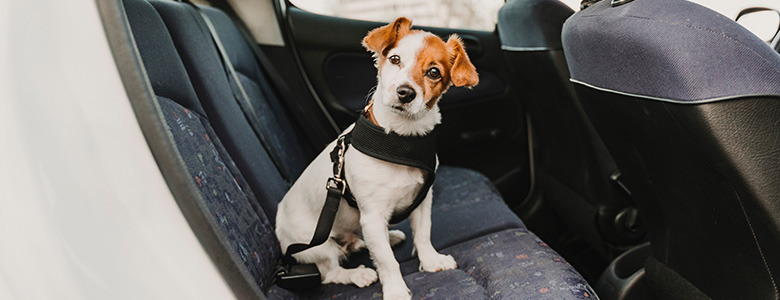Moving with animals can be challenging whether you have just a single pet or many. Pets are generally sensitive to commotion and changes in their surroundings, both of which are inevitable during a relocation. And an agitated pet only serves to complicate an already stressful move further. Logistics for properly moving with a pet can be complicated, and a plan should be thought out prior to moving day.
At Ace Moving & Warehousing, we've been moving Twin Cities families since 1958; in that time, we worked with thousands of pet owners. Over our decades of experience, we've witnessed what works and what definitely doesn't, so to help you move your pets as smoothly as possible, we've listed some helpful tips below.
Prepare Your Pet for Your Relocation
In the days leading up to moving day, do your best to maintain your pet's routine, even if you're busy and stressed. Pets do best with structure, so if you usually take your dog for a morning jaunt, make sure you do that, even on the morning of your move.
If you typically feed your pet a specific type of food, keep that consistent, too. Many people mistakenly think bringing special treats is an excellent way to comfort their pets during a move; however, that's usually not the case.
You never know how your pet's stomach will respond to new foods, so unless you're willing to clean up an accident inside your vehicle, keep all routines and foods consistent.

On Moving Day
Having pets inside the home can be difficult while movers are trying to work, so make special arrangements for your pet on the day of the move. This can be at a friend's house or the kennel. Not only is there a danger that your pet might be stepped on, but doors are constantly opening and closing, and a pet could get loose.
If alternative arrangements are not an option for your pet, have a system prepared to keep your pet behind closed doors. Move room to room, clearing the house before getting to the room where your pet is safely kept.
Be sure to have a big sign on the door notifying people that a pet is in the room to prevent any possible escapes. Communicate to the entire moving crew that there is a pet in the house so everyone is on the same page.
Keep the Essentials Handy
Once you move to your new home, make sure you have the essentials handy for your pet. Have a separate box of your pet's belongings that is easy to locate. This should include your pet's food, food and water bowls, a litter box and litter, and a leash.
Pack any comfort items for your pet, such as a bed or blanket. Making sure your pet is well taken care of immediately following the move will help to ease your mind.

Allow Your Pet Time to Adjust
Moving to a new house is a big adjustment. You have to completely unpack your life and start new again. This is the same for your pet. Your pet is new to the home, the location, and the smells inside the house.
Remember that your pet will need time to adjust. Having some known comforts for your pet will help tremendously. It may take your pet a few days to become accustomed to their new surroundings, so giving them time and space is important.
Don't Count on Your Movers to Transport Your Pet
Professional movers and packers cannot transport pets, so it's up to you to arrange a safe and comfortable means of transportation for your animal friend. Most relocators prefer to bring their pets in their vehicles, but if you're short on room, make alternate arrangements early.
If you have a trusted friend or relative familiar with your pet, consider asking if that person will pet-sit on move day. If you're relocating locally, see if they can transport your animal to your new home.
Driving With Pets: 5 Helpful Tips
The best way to drive with pets depends on what species of pet you own. But in general, you should keep your pet safely contained in a pet carrier or harness throughout your drive.
Though you can certainly let a well-trained pet (depending on the species, of course) roam free in the front seat, it's probably not a good idea. Since there's a long list of hazardous and valuable items your moving company cannot or will not transport, you'll need to pack those things in your vehicle. And if you want to keep your pet and belongings safe, it's best to prevent your animal from sticking its nose where it doesn't belong.
For long drives, here are a few additional helpful tips!
1. Try to Pull Over Every Two Hours
This allows your pet to relieve itself and get some exercise.
2. Bring Dishes for Food & Water
To stay on top of your regular feeding schedule.
3. Do Your Homework
If you plan to stop and eat at restaurants, you should never leave your pet in your vehicle unattended. Websites like DogFriendly.com and BringFido.com are useful for determining which restaurants along your route can accommodate your pet.
You can probably both use a breather during a long, stressful move.
4. Visit the Vet Before the Move
Before your leave, ensure your pet is in good health and up to date on all necessary vaccinations and checkups. If you're moving a dog, opting for a microchip is never a bad idea, just in case something unexpected happens during your journey.
5. Prepare for Nausea
Asking your vet about medications for car sickness. Even if your pet does well on short car rides, you never know how they will respond to an extended trip.

Flying With Pets: What You Need to Know
If you plan to fly to your new home, make arrangements for your pet as soon as possible. Many airlines have a cap on the total number of animals allowed on a single flight, while some airlines don't allow animals on the plane at all—make sure you do your research!
You should also expect to pay an additional fee for your airline ticket when you plan to transport your pet on a plane. As far as accommodations go, if your pet is small, you may be able to situate a carrier beneath the seat in front of you, much like you'd situate a normal carry-on bag.
If you have a large pet, you may have to put your animal in the plane's cargo hold. If that's the case, your pet may be timid or agitated after the flight, so be prepared.
Finally, just as you should visit your vet before a long car ride, you'll also need to take your pet in for a checkup before you get on a plane. Most airlines require an up-to-date health certificate for all animals on the flight, so make sure you get that before you're set to take off.
Your Packing & Moving Pros in the Twin Cities
If you're planning an upcoming move, don't hesitate to contact our Ace Moving & Warehousing team. We know moving with a pet can be a challenging, stressful experience for both of you, and we're here to help.
We specialize in various moving services designed to streamline your relocation, including full packing services, climate-controlled storage solutions, furniture moving, and more. When you need experienced professionals you can trust, we're the team to call!
To request a fast-moving quote or learn more about our services, call our team today at 763-755-2045 or send us a message, and we'll be in touch promptly.